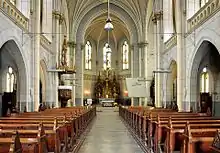Elisabetin Roman Catholic Church
The Church of the Sacred Heart of Jesus is a Roman Catholic church in the Elisabetin district of Timișoara. Located in Nicolae Bălcescu Square, the neo-Gothic church was built between 1912 and 1919 after a project by architect Károly Salkovits. Holy Masses are celebrated in German, Hungarian and Romanian. The church is run by Salvatorian monks, a relatively young order founded in 1881 in Austria.[1]
| Church of the Sacred Heart of Jesus | |
|---|---|
Biserica „Preasfânta Inimă a lui Isus” | |
 | |
| Religion | |
| Affiliation | Roman Catholic |
| Patron | Sacred Heart of Jesus |
| Year consecrated | 1919 |
| Status | Active |
| Location | |
| Location | Nicolae Bălcescu Square, Timișoara |
| Geographic coordinates | 45°44′28″N 21°13′35″E |
| Architecture | |
| Architect(s) | Károly Salkovits |
| Style | Gothic Revival |
| Groundbreaking | 1912 |
| Completed | 1919 |
| Specifications | |
| Capacity | 2,000 |
| Length | 52 m |
| Width | 22 m |
| Height (max) | 57 m |
| Website | |
| parohiaelisabetin | |
History
As early as 1899, an association for the construction of a Roman Catholic church was formed in the Elisabetin district.[2] The collection of the necessary sums began at the La trei coroane restaurant, where a fundraising event was organized every year.[3] In 1902, a piece of land was bought in the Grundhaus Square (present-day Nicolae Bălcescu Square) from George Buresch. For its construction, the bishop of Cenad, Sándor Dessewffy, assistant to the pontifical throne, donated 50,000 Kronen and requested that the church be of the Salvatorian Order.[4] In turn, mayor Carol Telbisz donated 60,000 bricks from the demolition of the old Piarist church and 80,000 Kronen.[3]
Built in eclectic style with neo-Gothic influences, with a capacity of 2,000 seats, the church was designed by the architect Károly Salkovits, from Budapest, who also took over the management of the site.[5] The foundation stone was laid in 1912, and the construction work was executed by Albert Schmidt and János Bagyánszky,[5] so that on 31 August 1913 the crosses were consecrated by Bishop Julius Glattfelder and fixed on the towers. Although the church could have been completed and put into use by the end of 1914, due to the outbreak of the war, many workers were mobilized on the front, and the entrepreneurs were unable to comply with their contractual obligations. However, thanks to the efforts of the association established in 1899 for the construction of the church, animated by the entrepreneurial spirit and funds of the bank director Aladár Kudelich and school principal József Wittenberger, the work was resumed by immediately after the end of the war, and the church was consecrated on 17 August 1919.[6] Upon completion, the pastorate was taken over by the Salvatorian Order, which will move its former residence here from the Mehala district.[7]
Architecture

From an architectural point of view, the church is built in the eclectic style with neo-Gothic influences. Among the neo-Gothic elements we can observe: the shape of the gaps – broken arch, the decorative rosette above the entrance, gargoyles, a decorative turret from the east and the branched veins on the inner vault.[8] The church impresses with its symmetry, slenderness, balanced distribution of interior space and giant stained glass windows that achieve good interior lighting in a warm yellow hue. The Gothic altar was brought from the old Roman Catholic church in Mehala, and the five altars that segment the interior were made in Ferdinand Stuflesser's workshop from Urtijëi (South Tyrol).[9] The church is 52 m long and 22 m wide. It has four towers, of which two towers with a height of 57 m.[2]
References
- "Biserica Preasfântă Inimă a lui Isus, Timișoara". Welcome to Romania.
- Both, Ștefan (12 August 2019). "O sută de ani de la sfințirea spectaculoasei biserici neogotice din Timișoara. Călugării Salvatorieni îi poartă de grijă de un secol". Adevărul.
- Păun, Liana (13 July 2014). "Somptuoasele biserici romano-catolice ale orașului. Unde se află „marele clopot" de peste două tone". pressalert.ro.
- Călin, Claudiu. "Biserici Romano-Catolice existente azi pe teritoriul orașului Timișoara". p. 3.
- Delesega, Gyula (2005). Temesvári kalauz (PDF). Timișoara: Marineasa. p. 152. OCLC 935481312.
- Geml, József (2016). Vechea Timișoară în ultima jumătate de secol (1870–1920). Timișoara: Cosmopolitan Art. p. 110.
- Moldovan, Mihai-Claudiu (18 October 2019). "Mănăstirea Ordinului Salvatorian din Timișoara". Heritage of Timișoara.
- "Biserica Romano-Catolică „Preasfânta Inimă a lui Isus"". Spotlight Heritage Timișoara.
- von Schuster, Else (1999). Temeswar – Timișoara. Bucharest: ADZ-Verlag. p. 117. ISBN 973-99655-4-7.
